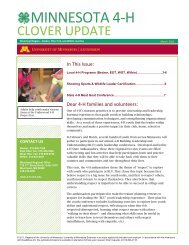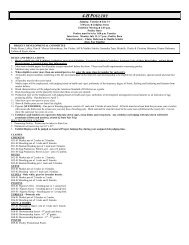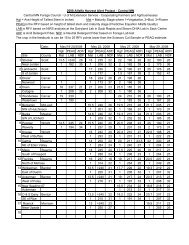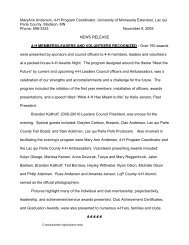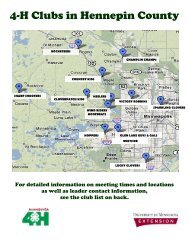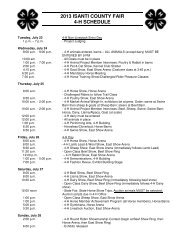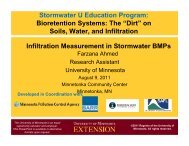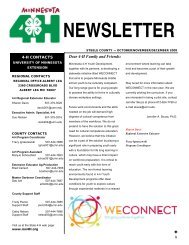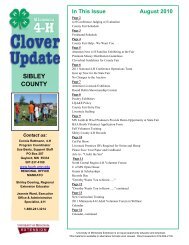Private Pesticide Applicator's Training Manual - University of ...
Private Pesticide Applicator's Training Manual - University of ...
Private Pesticide Applicator's Training Manual - University of ...
Create successful ePaper yourself
Turn your PDF publications into a flip-book with our unique Google optimized e-Paper software.
Page 9-158 <strong>Private</strong> <strong>Pesticide</strong> Applicator <strong>Training</strong> <strong>Manual</strong><br />
uniformity <strong>of</strong> the chemical distribution will be no better than the<br />
distribution <strong>of</strong> the water.<br />
Adjust the irrigation system (such as the end gun) to prevent spray going<br />
beyond the boundaries <strong>of</strong> the target field. Shut down the irrigation system<br />
if wind will carry chemical drift <strong>of</strong>f target. Manage the irrigation system so<br />
run<strong>of</strong>f or deep percolation <strong>of</strong> the water-chemical mixture does not occur.<br />
Do not chemigate in areas containing wetlands and other surface water<br />
bodies. Do not apply any pesticide that is not labelled for use in an<br />
irrigation system. Such applications are illegal and may adversely affect<br />
wildlife, non-target plants, and water quality.<br />
Inspect safety and antipollution equipment before each use<br />
Inspect all components <strong>of</strong> the chemigation and irrigation system before<br />
each use. Components not working at the time <strong>of</strong> inspection should be<br />
repaired or replaced before chemigating. Routine inspections should<br />
minimize the potential for failure <strong>of</strong> any component during chemigation.<br />
To inspect the irrigation pipeline check valve, low pressure drain,injection<br />
line check valve, low pressure switch and the power interlock follow the<br />
procedures listed below. RPZ backflow preventers and some other types <strong>of</strong><br />
check valves will require a different approach to inspection. Contact MDA<br />
staff for directions on inspecting if assistance is needed.<br />
n Connect the chemigation system to the irrigation system, but leave the<br />
chemical injection line/hose disconnected from the injection port check<br />
valve.<br />
n Start the irrigation pump and pressurize the irrigation system to its<br />
normal operating pressure.<br />
n Observe the injection line check valve to see if any water is leaking<br />
back out the inlet side <strong>of</strong> the check valve. There should be no leakage<br />
observed when the irrigation system is operating or when shut down.<br />
n Connect the chemical injection hose to the injection check valve and<br />
start up the chemigation system. The chemigation system should be<br />
operated only with clean water or nothing.<br />
n Close the main pipeline control valve (reducing the operating pressure)<br />
until the low pressure switch shuts down the irrigation system. The<br />
pressure switch should be set to cause the irrigation pump and system<br />
to shut down when the normal operating pressure has been reduced by<br />
15 to 25 percent. If no flow control valve is present, shut power <strong>of</strong>f to the<br />
pump and/or irrigation system and go to the next step.<br />
n Immediately after shutdown, observe if any water is flowing from the low<br />
pressure drain(s). Some drainage for a short period <strong>of</strong> time after<br />
shutdown is normal, but then drainage should stop.<br />
n Check to see if the chemigation injection device has stopped operating.<br />
This device should stop when the irrigation system and pump shut<br />
down. If the chemigation system has an agitation system this unit does<br />
not have to shut down when the injection device stops.<br />
n Open the inspection port at the main pipeline check valve assembly<br />
after the low pressure drain has stopped flowing. Inspect for any leakage<br />
from the check valve flapper. There should be no leakage from the




